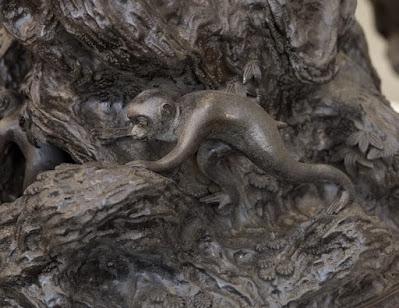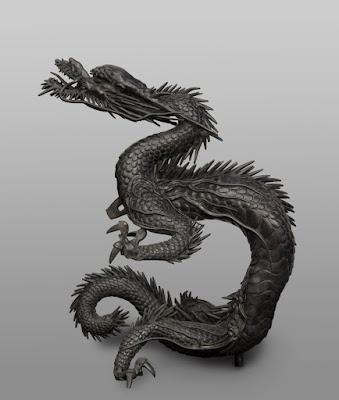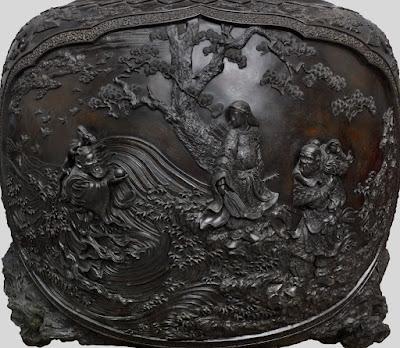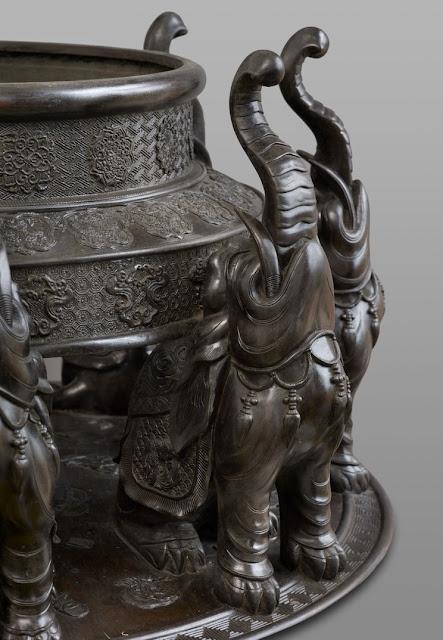Japanese Incense Burner
Manchester Museum (image credit: Sam Beath)
To understand the symbolism captured within the object, exploring when and why it was produced is useful. It was created sometime during the Meiji era (23 October,1868 – 30 July,1912) and before 1889, when it was acquired by the Whitworth Art Gallery. The working theory is that it was commissioned for the 1886 World’s Fair.The original purpose of this type of object was to burn incense during religious rituals. This practice developed in China was then brought to other countries such as Japan. Traditionally incense has been used as symbolic purification of an environment i.e. temple and it was thought to encourage the buddhas, gods, demons etc to make an appearance (KCP International, 2023).However, during the Meiji era these types of objects were often produced specifically for export, showcasing fine examples of Japanese bronze casting featuring religious iconography, both Buddhist and Shinto (the worship of spirits in the natural world) along with imagery of Chinese origins. During this time period, Japanese collectors also had a renewed interest in Chinese antiquities (Christies, 2023).To unpick the object’s imagery, a good starting point is the crowning glory, an eagle with ruffled feathers and its wings outspread as if it has just landed after a heavenly excursion. In Japanese mythology particularly in Shinto, the eagle god appears as Amenohiwashi-no-kami, the symbol for power (International Photography Awards, 2023). In Chinese tradition, this bird of prey symbolises strength.Sam Beath so kindly answered several questions regarding the incense burner’s provenance, narrative and symbolism. Some of her insights have been incorporated in this article. She also mentioned that Adela Hawley (recent Art Gallery and Museum Studies Graduate, University of Manchester) did extensive background research on this object. Much of Hawley’s information is put forward here:The top of the object also features monkeys fleeing from a large bird, this symbolises tricksters and troublemakers running away from a source of strength.
Japanese Incense Burner Detail
Manchester Museum (image credit: Michael Pollard)
Below this area cherry blossoms or ‘Sakura’ adorn branches - they are linked to the Shinto religion and represent hope, renewal and transience as blossoms are only present for a short while (JNTO, 2022).
Dragons in Japan are often portrayed as a three-clawed, serpent-like being and are believed to live below the sea, control the rain and bestow wishes (Schumacher, 1995).
Japanese Incense Burner Detail, one of seven dragons
Manchester Museum (image credit: Michael Pollard)
One of the larger scenes depicted on the urn shows the story of the Ryujin, the Dragon King of the Sea. He is able to metamorphose into any form he pleases, and as such can enter a human form. The seas are controlled by Ryujin using the ‘tide pearls’. A popular story often depicted in Meiji era art was the story of Takenouchi no Sukune (DMA, 2017). In this story Takenouchi defeats a sea monster and so a thankful Ryujin gifts him a jewel which controls the seas.
Japanese Incense Burner Urn Detail
Manchester Museum (image credit: Michael Pollard)
A turtle with a bushy-seaweed tail is visible near the bottom of the burner, and is used to represent wisdom and longevity. It could also be representing a ‘Minogame’ which is a mythical creature that originates from China and is believed to live up to 1,000 years (Ashkenazi, 2003). The Minogame is most commonly associated with the folktale Urashima Taro as well as, Jurojin, one of the seven gods of luck. The turtle symbol was also used by the seafaring god Kumpira, as a protective emblem against the elements (Young, 2003). Similarly, cranes symbolise good luck and longevity and are often depicted alongside Minogame.
Part of the structure of the burner features elephant-like creatures. Initially, they were believed to depict elephants…With further investigation it can be theorised that the ‘elephants’ are actually ‘Baku’ a mythological beast that is believed to devour bad dreams and evil spirits. The Baku is a chimera, usually comprised of an elephant nose, tigers feet and an ox’s tail. The Baku is part of both Japanese and Chinese folklore and is a protector who eats bad dreams, however, if the Baku is not satisfied with the nightmare, they are said to then devour a person’s hopes and dreams. Legend states that the Baku was created from spare pieces left by the gods after creating the other animals (Reese, 2014).Japanese Incense Burner Baku Detail
Manchester Museum (image credit: Michael Pollard)
The Japanese Incense Burner at Manchester is a special object. One can marvel at the traditional symbolism presented in intricate detail and the cast-metal craftsmen who created it and also those who lovingly brought it back to life for present and future generations to enjoy.
A big thank you to Sam Beath, Adela Hawley, Michael Pollard and Manchester Museum.
Japanese Incense Burner The eagle watches over all, such power
alights to own the mountain as tricksters flee
fixed in space, the fine well-crafted universe
cast two centuries before has lovingly
been restored, reborn cherry blossoms flower
clinging tight to their moulded metal mothers,
those trees snaking upwards towards ceiling and sky,
handles like serpents mirroring each other.
See these entities, branched umbilical cords
attached to round belly, the urn supported
by elephant-like sentries, lucky Baku
their seven backs laden, treasure transported
to heaven yet grounded, they cannot escape
dragons’ hot breath beneath their feet, a fire ring
of desires to know, those who are wondering
who made this, and us, and everything.
Thanks for reading,
Kate J
Email ThisBlogThis!Share to TwitterShare to Facebook





